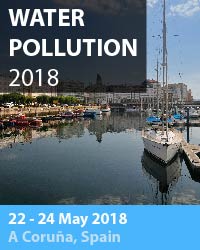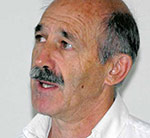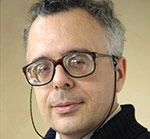Water Pollution 2018
14th International Conference on Monitoring, Modelling and Management of Water Pollution
![]()
22 - 24 May 2018
A Coruña, Spain
Overview
 The 14th International Conference on Monitoring, Modelling and Management of Water Pollution took place in A Coruña, Spain organised by the Wessex Institute and University of A Coruña and chaired by Professors Santiago Hernandez and Stefano Mambretti, both Directors of WIT. The meeting was sponsored by WIT Transactions on Ecology and the Environment and the International Journal of Environmental Impacts.
The 14th International Conference on Monitoring, Modelling and Management of Water Pollution took place in A Coruña, Spain organised by the Wessex Institute and University of A Coruña and chaired by Professors Santiago Hernandez and Stefano Mambretti, both Directors of WIT. The meeting was sponsored by WIT Transactions on Ecology and the Environment and the International Journal of Environmental Impacts.
The meeting has been held in a variety of different locations every two years since it started in Southampton in 1991. The Conference provides a forum for discussion amongst scientists, managers and academics from different areas of water contamination. The wealth of information exchanged in this international meeting continues to be of great benefit to all involved with water pollution problems.
Located in the verdant agricultural region of Galicia, La Coruña is home to Roman remains, castles, museums and sumptuous produce markets, and is perhaps most famous for its excellent fish and seafood. A new promenade frames the waterfront, extending the length of the city and linking its many attractions, shopping areas and beaches. The nineteenth century centre is noted for its unusual Galerias – glazed balconies on the front of the buildings - which allow the city’s residents to enjoy the Atlantic views year round. A landmark of the city, the 2,000 years old tower of Hercules is the oldest lighthouse in existence, a World Heritage site and National Monument of Spain.
The environmental problems caused by the increase of pollutant loads discharged into natural water bodies require the formation of a framework for regulation and control. This framework needs to be based on scientific results that relate pollutant discharge with changes in water quality. The results of these studies allow industry to apply more efficient methods of controlling and treating waste loads, and water authorities to enforce appropriate regulations regarding this matter. Environmental problems are essentially interdisciplinary. Engineers and scientists working in this field must be familiar with a wide range of issues and, in view of the scarcity of available data, it is important that experiences are shared on an international basis.
Opening of the Conference
Stefano opened the meeting by explaining the importance of the conference series to fulfil WIT’s objectives, ie the transfer of knowledge at international level. The Institute has carried out several research projects in the past on environmental related issues and it is always interested in this scientific field.
Over the years WIT conferences have published a substantial number of papers which, since 1993, have been archived in the Institute’s eLibrary (https://www.witpress.com/elibrary), which are Open Access to ensure the maximum dissemination to the work done by the scientific community. In addition to Conferences, WIT organises a series of short courses, some of them directed towards industry.
Research activities continue to be carried out at the Institute campus in the New Forest in England. There, further advances continue to be made in the theory and applications of the Boundary Element Method (BEM), a technique originated in the research carried out by the WIT group when at Southampton University. Since 1986, when the Wessex Institute was created, the work has been centred in the New Forest.
The R&D on Boundary Elements continues to generate better computational tools for the solution of scientific and engineering problems. Some applications were shown to demonstrate the versatility of the method and how it can be applied to solve a wide variety of problems.
WIT Press, the publishing arm of the Institute, has launched a series of interdisciplinary journals in fields not properly covered by other publications. The International Journals published by WIT Press are:
- Sustainable Development and Planning
- Design and Nature, and Ecodynamics
- Safety and Security Engineering
- Computational Methods and Experimental Measurements
- Energy Production and Management
- Heritage Architecture
- Transport Development and Integration
- Environmental Impacts: Management, Mitigation and Recovery
These journals were launched in an effort to support the setting up of scientific publications independent of major commercial companies. The most appropriate for this meeting is Environmental Impacts.
Stefano finished his introduction by wishing the participants a successful conference and thanking them for their support of Wessex Institute activities.
Invited Speakers
The Conference sessions were enhanced by a series of invited lectures, ie:
- “SEDUNIT Project: study of the accumulation erosion and sediment transport of cohesive solids in combined sewer systems”, by Jose Anta Alvarez, University of A Coruña, Spain.
- “Dredging works monitoring in the Port of Civitavecchia (Rome, Italy): sedimentological and geo-chemical investigations”, by Giuseppe Zappala, National Research Council, Italy.
- “Monitoring micropollutants in surface and subsurface runoff in the Swist river basin” by Ekkehard Christoffels, Erftverband Water Association, Germany.
- “Public concerns about water pollution between 2002 and 2017 in the Pacific Northwest, USA”, by Robert Mahler, University of Idaho, United States.
Conference Sessions
The papers in the conference were classified in the following sessions:
- Water contamination
- Wastewater management
- Groundwater and aquifers
- Freshwater quality
- Water contamination
- Water management
Excursion
During the second day of the conference an excursion was arranged to the University of A Coruña. The Center for Technological Innovation in Construction and Civil Engineering (CITEEC) was created with the purpose of improving investigation and research in the field of construction, specifically civil engineering, from an experimental analysis approach.
CITEEC currently supports ten areas of activity, represented by these laboratories:
- Construction Laboratory
- Laboratory of Hydraulics
- Laboratory of Instrumentation and Intelligent Systems in Civil Engineering
- Laboratory of Numerical Methods in Engineering
- Laboratory of Ports and Coasts
- Laboratory of Railway Engineering and Transport
- Laboratory of Roads and Geotechnics
- Laboratory of Rock Mechanics
- Laboratory of Sanitary and Environmental Engineering
- Wind Tunnel Laboratory for Aeroelastic Testing
Every laboratory generates their own projects and uses their own equipment and facilities, which are all part of the center.
CITEEC is directly linked to the University of A Coruña and was created in 2000 (inaugurated on June the 6th, 2000). CITEEC develops three key areas of activity, coinciding with the three pillars of university research:
- Promotion of basic research: Conducting studies to expand knowledge in all fields related to civil engineering. The realization of doctoral theses and degree dissertations is the mechanism that promotes this kind of research, closely linked to the university departments.
- Applied research: Using any of the usual mechanisms for raising funds for research (Autonomous Region government, Ministry for Science and Education, EU), the CITEEC serves as a support for research projects in collaboration with companies and agencies.
- Consultancy to companies and institutions: The CITEEC is a very remarkable framework, unique in the Autonomous Region of Galicia, available to businesses and institutions through cooperation agreements to support the implementation of projects or activities that require physical model studies, or infrastructure studies in detail.
Conference Dinner
The International Scientific Advisory Committee of the conference met over dinner in a local restaurant. The organisers thanked the committee members for their help in reviewing abstracts and papers, thus ensuring the high quality of presentations. New conference topics were discussed, as well as future locations and the possibility of adding new members to the committee.
The Conference dinner took place at Restaurant Domus, situated inside the Domus Museum, and offers wonderful views of the bay and city of A Coruña. The delegates were treated to traditional Galician food and fine local wines together with a music quartet.
Closing of the Conference
The conference was closed by Santiago who expressed his appreciation to the delegates for having participated in Water Pollution 2018 and hoped that they would consider attending the next meeting in the series.
Related Conferences
SDP 2018, 4 - 6 September 2018
Water Resources Management 2019, 7 - 9 May 2019
River Basin Management 2019, 8 - 10 May 2019
Coastal Cities 2019, 11 - 13 September 2019
Water & Society 2019, 2 - 4 October 2019




 Wessex Institute
Wessex Institute